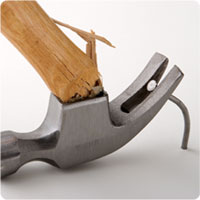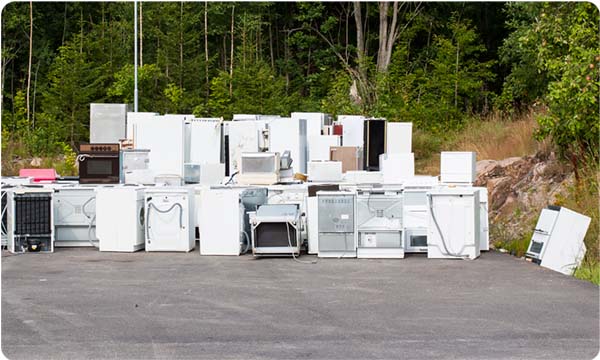
More Articles

Products should last.
It seems we are living in a disposable society. When $1,000 cell phones are expected to be replaced every two years, three hundred million dollar stadiums are torn down in less than 30 years, clothing gets ditched as often as fashion changes, and you don’t expect children’s toys to last longer than it takes to get them home, it’s frustrating and discouraging. But worse, today, we’ve come to expect it and even justify it.

Not that I was a big fan of Bell Telephone, but I remember when phones were manufactured and owned by Ma Bell, and they seemed to last forever. The Roman Aqueducts, while no longer in use, still stand as sturdy as ever more than 2,000 years after construction. Who remembers when a washer or dryer would last for 20-30 years?
“They don’t make ‘em like they used to” is not simply a pithy adage. It’s a statement based in fact, a fact each of us experiences every day. Whether this is a result of corporate greed, rising labor and materials costs, the desire to get something for nothing, loss of skilled labor, lack of pride in one’s workmanship or whatever other ideological “ism” one may subscribe to, the result is the same. We’ve grown accustomed to fragile pieces of plastic that have no “legs” and are considered disposable even though they shouldn’t be looked at that way.
It applies to our industry as well.

In duct cleaning and HVAC rehabilitation, the main criteria is that the system is actually cleaned thoroughly, properly and to a very high standard, whether it is vacuuming the interior surfaces of the system or reparing and sealing a condensate pan as shown in the photos above.
But beyond the obvious step of doing a complete job of cleaning, what fits into this concept of "build it to last"? There are many variables that can cause a system to become contaminated again that they are hard to control. Things such as a construction project in the space, water leaks, failure to properly maintain the system. A client can take many steps to ensure that the cleaning done does last. But that's not the point of this article.
The question is what can or does a duct cleaning contractor do to maximize the life span of the newly cleaned and rehabilitated system the contractor has just spend so much time and effort to produce?
It boils down to a few things:
- First, to restate the most important and obvious. The job is done thoroughly with no ommissions or shortcuts. That is, the system is, in fact, cleaned. And it is done to the standards laid out by NADCA (National Air Duct Cleaners Association).
- The work is done by people who know what the heck they are doing. It is not a profession requiring college degrees or internships, but is a highly specialized trade carried out by technicians with a willingness to get their hands dirty and to do the things that need doing even though the final product won't nescessarily be seen by the client. After all, air ducts are above ceilings and behind walls. Air Conditioning equipment is on rooftops or in basements. Who's going to know if we didn't really clean the whole thing? We'll know.

- Materials of the highest quality and durability are used in carrying out the project.
Duct cleaning is a trade that is heavily labor intensive. Materials and supplies are not the heavy expense, and the materials don't do the cleaning, technicians do. But that is no reason not to use the best quality supplies available - cleaning agents, metals, insulation, down to the tools and equipment used to do the work. It's tempting to skimp on materials or to get something else because it's cheaper, but doing so can often sabotage the longevity of the project. Along with this, ensure that every care is taken to ensure the proper use and installation. In other words, attend to all the details.
- There are always things to learn, technical improvements and fine tuning of already established procedures.
This is true of any profession. This is how we came across the use of non-fiberglass insulation, variously trade named "Astroloil" or "Reflectix". Talk about built to last!

This is the interior of an air handler where, in 2005, we installed Astrofoil over a new layer of fiberglass insulation. 14 years later, in 2019, the client reached out for us to clean the system again and this is how we found it. The only thing we needed to do with the Astrofoil was wipe down the surface and do a bit of touch up on the edges. We had delivered a product that lasted!
- Ensuring that a system, once cleaned, stays clean involves a cooperative action between the duct cleaning contractor and the client or building owner.
Duct cleaning is not a "set it and forget it" type operation. It won't just magically stay clean or be "built to last" without any attention at all. It requires things from both the duct cleaning contractor and the client, engineer or building management. Of course the contractor must do the job right in the first place, but part of that job is to inform the building management of any mechanical issues that need to be handled such as broken dampers, leaks in the system, poorly installed sections of ductwork, etc. The contractor should also inform the building management of anything that might reduce the longevity of the system, such as misalignment of blower motors, poorly fitting doors, and the like.Building management, of course, is responsible for regular maintenance of the system after cleaning. Change the filters on a regular basis, adjust controls periodically, ensure the system is off line during dusty remodeling. Some of the regular maintenance may involve calling in the duct cleaning contractor to clean coils or touch up certain areas. Whatever periodic maintenance is undertaken will extend the life of the system and when you're talking about machinery that has costs into the 6 figures, that maintenance more than pays for itself.In duct cleaning, it really does come down to the old saying "do it right the first time!"
Until next time!







